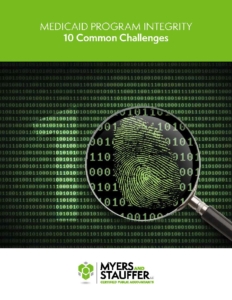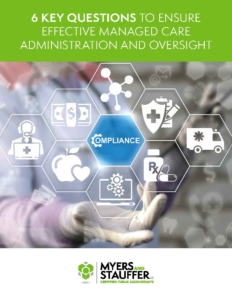Health Care IT Consultants
Myers and Stauffer’s health information technology (health IT) consultants are ready to design effective, yet realistic strategies that work for you. We understand health IT and culture change go hand-in-hand and that managing change can be as important as the change itself. Our mission is to provide strategies, insight, and innovative solutions to navigate industry challenges, emerging trends, and technological advancements.
Whether you need assistance with evaluating the sustainability of a health information exchange (HIE), the development of a health IT roadmap, identifying strategies to maintain systems after Health Information Technology for Economic and Clinical Health (HITECH) sunsets and approaches to leverage Medicaid Management Information Systems (MMIS) funding, evaluating system and programmatic needs, or engaging stakeholders to create a more collaborative environment, we are here to assist you.
The great potential of health care data will be realized when health care professionals have access to critical patient information precisely when it is needed.
Health Information Exchange Sustainability Assessment
Read More
What is an HIE Sustainability Assessment?
As states pursue enhanced federal funding and establish partnerships with health information organizations, they should first assess their HIE’s long-term sustainability and viability.
Our health IT experts conduct a 7-point HIE sustainability assessment to answer the single most important critical question:
Are the business, financial and technology practices of the HIE organization performed in order to enable long-term sustainability?
A few of these components include:
- HIE Governance. Creating structures and processes to make decisions and resolve issues are key to successful HIE organizations. We examine the organization’s governance practices and review areas such as:
- Broad representation of the stakeholders participating in the HIE.
- Whether there is a clear mission and vision and specific policies and procedures.
- Use of data sharing agreements to address data access and permitted uses of information.
- Determine the existence of strategic plans and other guiding documents to ensure participant needs are being met.
- Participant Acquisition and Management. Techniques used to manage both prospects, and retain existing customers, are important to longevity and profitability.Our experts understand the needs of HIE participants, and importance of HIE organizations to demonstrate valuable service offerings to fulfill those desires. Our assessment identifies areas for maximum utilization of services and opportunities for HIEs to enhance communication and marketing endeavors.
- Business Process and Organizational Capabilities. Myers and Stauffer analyzes the alignment and integration of tangible and intangible assets to the HIE’s overall organizational strategy.To ensure superior use of business process and organizational capabilities, we examine areas such as strategic job families; IT portfolio; organizational change agenda; human, information, and organizational capital; and readiness to determine whether advanced planning and coordination efforts are sufficient.
- Technical Architecture and Data Management. The data needed for organizational decision-making and reporting should always be available, accurate, complete, and secure.Myers and Stauffer consultants are experienced in assessing current enterprise technology architecture, features, functionality, development of interfaces, and related health IT infrastructure. Assessing these areas helps to determine the effectiveness and efficiency of each component related to how data is created, stored, exchanged, and used.
- Product Development and Interoperability. The product development process is crucial in any business, and especially for the long-term sustainability of HIEs.Our health IT experts understand the importance for an HIE organization to maintain a complete product life cycle model that produces new and enhances existing products and services to meet participants’ needs and wants. Our analysis examines how the HIE selects products and services for development and whether it is effective in satisfying participants’ wants or market niche.
- Privacy and Security. At a fundamental level, the privacy, confidentiality, security, and information use challenges facing HIEs are the same as those faced by any health care entity. The uniqueness of HIEs — structures, relationships, funding, and authority — adds new complexities to the familiar issues of privacy, confidentiality, security, and information use.[1]Our team explores efforts the HIE organization may take to resolve barriers and free the flow of electronic health information while preserving privacy and security requirements to ensure continuous system monitoring and evaluation over time.
- Financial Management. The most critical element in creating a successful health exchange is determining a financial sustainability model for the HIE.Myers and Stauffer is uniquely positioned with financial specialist who can apply their expertise to assess the viability of the HIE organization’s productivity and growth strategies, stakeholder value proposition, current revenue sources, impact of funding sources, and overall financial health.
An optional feature to the HIE Sustainability Assessment is the customized implementation of an HIE Certification Program. The HIE Certification Program is specifically designed for a state to leverage its relevant laws, regulations, and/or directives to create a process by which the HIE may be eligible for funding or even operate in the state.
Why should a state conduct an HIE Sustainability Assessment?
A comprehensive assessment can identify potential problem areas. Without this knowledge, states may unknowingly continue to fund suboptimal HIEs that are at risk for failure.
How does an HIE Sustainability Assessment support HITECH to MMIS funding transition?
An HIE assessment provides states with insights about their HIE’s business, technology, and financial management practices. An assessment can present the state with insights as to whether these practices are sound, and more importantly, the likelihood of the HIE organization to be sustainable for the long-term.
Additionally, the assessment examines the organization’s product development and interoperability capabilities. In order to ensure projects and use cases are properly aligned to advance states’ MITA maturity, the HIE assessment may identify opportunities for services and technology enhancements to best achieve the Medicaid Enterprise System goals.
Statewide Health IT Roadmap
Read More
What is a Statewide Health IT Roadmap?
Myers and Stauffer’s Health IT consulting team assists clients in critically analyzing their health IT resources, infrastructure, and pathways necessary to achieve their long-term health care objectives. This analysis becomes the Health IT Roadmap, a tool to support implementation of the state’s health IT strategy and interoperability goals and objectives over three to five years.
Why should a state develop a Health IT Roadmap?
The Roadmap development process gathers information from stakeholders, assesses the current statewide data exchange infrastructure, and explores potential policies and technical solutions.
How do states benefit from a Statewide Health IT Roadmap?
The process generates a three to five-year plan of initiatives aligned with CMS priorities and seeks to increase interoperability among providers, health care organizations, and state agencies.
How does a Statewide Health IT Roadmap support HITECH to MMIS funding transition?
The Roadmap catalogs current and anticipated health IT and HIE functionality, identifies projects and use cases to advance states’ Medicaid Information Technology Architecture (MITA) maturity, and presents opportunities for services and technology enhancements to best achieve the Medicaid Enterprise System goals.
Health Information Exchange Certification
Read More
What is Health Information Exchange certification?
Myers and Stauffer has developed an HIE certification program, including a proven process and toolkit set of artifacts for use by our state clients to ensure all operating HIEs within their state are following applicable laws, regulations, and direction while also using interoperability standards.
How do states benefit from a HIE certification?
HIE certification improves trust among stakeholders, state government, and HIE organization participants. The process assists our state clients in addressing any barriers between the HIE(s), the state, and community providers, such as mistrust regarding data security and compliance, and serves as an avenue to improve collaboration or transparency.
How does a HIE certification support HITECH to MMIS funding transition?
Improving adoption of HIE in the community which in turn, improves health outcomes and care coordination, ultimately improves the Care Management MITA business area.
Statewide Health IT/HIE Governance
Read More
What is Statewide Health IT/Health Information Exchange Governance?
Fragmented health IT and HIE governance limits the ability to coordinate projects and promote value propositions, leading to reduced adoption, exchange, and use of data by providers, and limits long-term sustainability of health IT investments.
As the largest health care payer and investor in health IT, state Medicaid agencies play a prominent role in governance and must be informed by community stakeholders, including providers, commercial payers, community-based organizations, and patients.
Our experienced health IT and Medicaid consultants assist states to develop and implement structured governance in order to best ensure investments and targeted use cases align with state and community needs and goals to achieve immediate and ongoing success in health IT deployment.
How does the State benefit from a Statewide Health IT/HIE Governance?
A coordinated governance framework benefits states by providing the structure necessary to collaboratively strategize and develop key solutions. Creating a structured statewide health IT governance model will ensure that investments align with state and community needs and goals, will improve coordination of projects and will lead to increased adoption, exchange, and use of data.
How does Statewide Health IT /HIE Governance support HITECH to MMIS funding transition?
A robust governance model supports the Medicaid Enterprise and justifies MMIS funding for design, development, and implementation (DDI) and long-term maintenance and operations (M&O) funding to enhance technical capabilities to support Medicaid providers, programs, and business processes.
Stakeholder Engagement and Environmental Scan
Read More
What is the purpose of stakeholder engagement?
By engaging both state and community stakeholders and creating an inventory of health IT assets, states will discover the key people, process, and technology assets to identify possible gaps in the statewide health IT infrastructure.
Myers and Stauffer’s consultants have helped numerous state clients successfully conduct stakeholder engagement and statewide environmental scan activities. These actions have given state Medicaid agencies the insights necessary to identify existing health IT/HIE projects, systems, and services; coordination of future projects; and improve collaboration and transparency.
Why should a state conduct stakeholder engagement activities and perform an environmental scan?
Stakeholder engagement and an environmental scan are prerequisites for other key efforts such as building the State Medicaid Health IT Plan (SMHP), statewide health IT roadmap, etc.
How do stakeholder engagement activities and an environmental scan support HITECH to MMIS funding transition?
These activities give states the knowledge and information necessary to review priority goals identified by the health care community and align to current and planned health IT functionality and use case throughout MITA and other state business processes.
Enterprise Data Governance for State Health and Human Services Agencies
Read More
What is Enterprise Data Governance?
Data governance is the organizing framework for establishing strategy, objectives, and policy for effectively managing data. It consists of the processes, policies, organization, and technologies required to manage and ensure the availability, usability, integrity, consistency, audit ability, and security of data.
Why should state Health and Human Service agencies implement Enterprise Data Governance?
State health and human services agencies commonly suffer from data silos, lack of data normalization, and data quality concerns. With little to no data governance, a state agency is less likely to effectively employ analytical, predictive, and eventually prescriptive reporting capabilities necessary to generate insights needed by government leadership for effective program and policy-making.
Myers and Stauffer data management experts employ a proven data governance framework to implement enterprise data governance across state health and human services agencies, establishing the data “Rules of the Road” to:
- Streamline and unify their approach to managing data.
- Ensure the right resources are involved in determining standards, usage, and integration of data across projects, subject areas, and lines of business.
- Minimize siloed project delivery and implementation.
- Aid in limiting challenges associated with managing systems.
- Reduce persistent data quality issues.
Our proven data governance strategy requires a unique combination of people, processes, technology, and controls. We employ a comprehensive approach that supports the alignment of Medicaid information demands with value delivery across individual agency units and the organization as a whole. Governance will be established encompassing Medicaid data across these units to drive visibility and awareness and enable the program to be successful.
How do states benefit from Enterprise Data Governance?
Implementing a data governance organization provides health and human services agencies with a framework to improve data quality by establishing strategies, objectives, and policies for effective enterprise-wide management of data.
By breaking down the silos and establishing sound data management practices, the state health and human services enterprise will have the knowledge and tools to effectively reduce duplicated systems and projects, improve data quality, streamline the reporting process, and enable critical data-driven decision-making.
Value-Based Purchasing (VBP) and Electronic Clinical Quality Measures (eCQMs)
Read More
Why should states build an Electronic Clinical Quality Measures (eCQM) program?
As states are moving from fee-for-service to value-based payments, creating and implementing an eCQM program becomes necessary.
States are offering financial rewards to providers who enhance their performance, meet state-specific benchmarks, and ultimately enable improvements in population health outcomes.
To facilitate eCQM reporting, states may consider leveraging their existing State-Level Repository infrastructure and architecture used for the Promoting Interoperability Program (formerly the Electronic Health Record Incentive Payment Program) or partner with the statewide HIE to create a reporting tool.
How does an eCQM program support HITECH to MMIS funding transition?
Incorporating eCQMs into delivery system and payment transformation supports state program design and policy consideration, as well as the measurement of the effectiveness and outcome of those efforts in a standardized, electronic, and efficient manner.
Health IT Technical Assistance
Read More
In addition to our menu of services, we can provide general health IT technical assistance and support which may include:
- Strategic planning for Medicaid IT enterprise architecture and interoperability design.
- State Medicaid Health IT Plan (SMHP).
- Funding requests including grant writing and proposal responses.
- Advanced Planning Document (APD) drafting, review, and CMS coordination.
- Social determinants of health and behavioral health integration and strategy.
- Delivery system reform initiatives.
- Legislation and policy review, analysis, and drafting.






